Improvement of 5G Transportation Services with SDN-Based Security Solutions and beyond 5G
Abstract
:1. Introduction
2. Literature Review and Related Work
2.1. Transportation with Future Technologies
2.2. Existing Transportation Services with SDN
2.3. Network Traffic Issues with SDN Based IoT
2.4. Ways of Network Traffic Measurement
2.5. Intelligent Approach to Secure Solutions
3. A Framework of 5G Transportation
3.1. A Proposed Framework
3.2. Modeling Framework for Self-Driving
- 1.
- Accessing multiple flows of traffic.
- 2.
- Priority of traffic.
- 3.
- Dynamic traffic.
- 4.
- Intelligent traffic.
3.3. Functionalities of the Framework
4. Traffic Measurement with SDN
4.1. Measurements with Network Parameters
4.2. Generic Measurements of the Framework
4.3. Traffic Prediction
- Driverless vehicles face many different objects, which are not in the programmed list.
- With natural weather conditions, smart environments should be secured for 24 h and seven days. These environments will be the best when service providers maintain risk prediction systems.
- Emergencies depend on many unexpected problems created by many risks, such as human errors.
- Energy management provides energy according to the needs of the electronic devices used in driverless vehicles. Here, the risks are the reliability of the devices because the failure of devices causes many problems such as accidents.
- Cybersecurity is one of the potential issues created by risks, such as the failure of electronic components used in driverless vehicles.
5. Transport Management with SDN
5.1. Traffic Priority
5.2. Traffic Load
5.3. Energy-Saving Based on Traffic
5.4. Security Based on Traffic
5.5. Intelligent Security Solutions
6. Transportations in 5G and Beyond
6.1. Solutions
6.2. Challenges
7. Conclusions and Future Work
Author Contributions
Funding
Acknowledgments
Conflicts of Interest
References
- Gohar, A.; Gianfranco, N. The Role of 5G Technologies in a Smart City: The Case for Intelligent Transportation System. Sustainability 2021, 13, 5188. [Google Scholar] [CrossRef]
- Noh, G.; Kim, J.; Choi, S.; Lee, N.; Chung, H.; Kim, I. Feasibility Validation of a 5G-Enabled mm Wave Vehicular Communication System on a Highway. IEEE Access 2021, 9, 36535–36546. [Google Scholar] [CrossRef]
- Chowdhury, M.Z.; Shahjalal, S.A.; Yeong, M.J. 6G Wireless Communication Systems: Applications, Requirements, Technologies, Challenges, and Research Directions. IEEE Open J. Commun. Soc. 2020, 1, 957–975. [Google Scholar] [CrossRef]
- Luo, M.; Lin, S.C.; Akyildiz, I.F. Multi-Controller Control Traffic Balancing in Software-Defined Networks. US Patent 15/199,387, 4 January 2018. [Google Scholar]
- Mahmood, A.; Casetti, C.; Chiasserini, C.F.; Giaccone, P.; Härri, J. Efficient Caching Through Stateful SDN in Named Data Networking. Trans. Emerg. Telecommun. Technol. 2018, 29, e3271. [Google Scholar] [CrossRef] [Green Version]
- Pan, M.S.; Lin, T.M.; Chiu, C.Y.; Wang, C.Y. Downlink Traffic Scheduling for LTE-A Small Cell Networks with Dual Connec-tivity Enhancement. IEEE Commun. Lett. 2016, 20, 796–799. [Google Scholar] [CrossRef]
- Agiwal, M.; Roy, A.; Saxena, N. Next Generation 5G Wireless Networks: A Comprehensive Survey. IEEE Commun. Surv. Tutorials 2016, 18, 1617–1655. [Google Scholar] [CrossRef]
- Pinto, P.R.; Cardoso, R.; Amaral, P.; Bernardo, L. Lightweight Admission Control and Traffic Management with SDN. In Proceedings of the 2016 IEEE International Conference on Communications (ICC), Kuala Lumpur, Malaysia, 22–27 May 2016; pp. 1–7. [Google Scholar] [CrossRef]
- Dighriri, M.; Lee, G.M.; Baker, T. Measurement and Classification of Smart Systems Data Traffic Over 5G Mobile Networks. In Technology for Smart Futures; Springer: Cham, Switzerland, 2018; pp. 195–217. [Google Scholar] [CrossRef]
- Shu, Z.; Jiafu, W.; Jiaxiang, L.; Shiyong, W.; Di, L.; Seungmin, R.; Changcai, Y. Traffic Engineering in Soft-Ware-Defined Networking: Measurement and Management. IEEE Access 2016, 4, 3246–3256. [Google Scholar] [CrossRef]
- Li, S.; Xu, L.D.; Shanshan, Z. 5G Internet of Things: A Survey. J. Ind. Inf. Integr. 2018, 10, 1–9. [Google Scholar] [CrossRef]
- Cia, M.D.; Mason, F.; Peron, D.; Chiariotti, F.; Polese, M.; Mahmoodi, T.; Zorzi, M.; Zanella, A. Using Smart City Data in 5G Self-Organizing Networks. IEEE Internet Things J. 2018, 5, 645–654. [Google Scholar] [CrossRef] [Green Version]
- Dao, N.-N.; Park, M.; Kim, J.; Paek, J.; Cho, S. Resource-Aware Relay Selection for Inter-Cell Interference Avoidance in 5G Heterogeneous Network for Internet of Things Systems. Futur. Gener. Comput. Syst. 2018, 93, 877–887. [Google Scholar] [CrossRef]
- Chen, M.; Yongfeng, Q.; Yixue, H.; Yong, L.; Jeungeun, S. Data-Driven Computing and Caching in 5G Networks: Architecture and Delay Analysis. IEEE Wirel. Commun. 2018, 25, 70–75. [Google Scholar] [CrossRef]
- Sun, D.; Zhao, K.; Fang, Y.; Cui, J. Dynamic Traffic Scheduling and Congestion Control across Data Centers Based on SDN. Future Internet 2018, 10, 64. [Google Scholar] [CrossRef] [Green Version]
- Gamage, S.; Khan, J.Y.; Ngo, D.T. Adaptive Resource Allocation with Traffic Peak Duration Prediction and Admission Control for Cognitive Wi-Fi Networks. Comput. Netw. 2018, 142, 240–252. [Google Scholar] [CrossRef]
- Shen, D.; Yan, W.; Peng, Y.; Fu, Y.; Deng, Q. Congestion Control and Traffic Scheduling for Collaborative Crowdsourcing in SDN Enabled Mobile Wireless Networks. Wirel. Commun. Mob. Comput. 2018, 2018, 9821946. [Google Scholar] [CrossRef] [Green Version]
- Fodor, G.; Vinogradova, J.; Hammarberg, P.; Kumar, K.N.; Hieu Do, R.B.; Baig, M.U. 5G New Radio for Automotive, Rail, and Air Transport. arXiv 2021, arXiv:2101.08874. [Google Scholar]
- Petrov, V.; Lema, M.A.; Gapeyenko, M.; Antonakoglou, K.; Moltchanov, D.; Sardis, F.; Samuylov, A.; Andreev, S.; Koucheryavy, Y.; Dohler, M. Achieving End-to-End Reliability of Mission-Critical Traffic in Softwarized 5G Networks. IEEE J. Sel. Areas Commun. 2018, 36, 485–501. [Google Scholar] [CrossRef]
- Semiari, O.; Saad, W.; Bennis, M.; Debbah, M. Integrated Millimeter Wave and Sub-6 GHz Wireless Networks: A Roadmap for Ultra-Reliable Low-Latency Communications. arXiv 2018, arXiv:1802.03837. [Google Scholar]
- Malila, B.; Falowo, O.; Ventura, N. Intelligent NLOS Backhaul for 5G Small Cells. IEEE Commun. Lett. 2018, 22, 189–192. [Google Scholar] [CrossRef]
- Tajiki, M.M.; Akbari, B.; Mokari, N. QRTP: QoS-Aware Resource Reallocation Based on Traffic Prediction in Software Defined Cloud Networks. In Proceedings of the 2016 8th International Symposium on Telecommunications (IST), Iran, Tehran, 27–28 September 2016; pp. 527–532. [Google Scholar]
- Awobuluyi, O.; Nightingale, J.; Wang, Q.; Alcaraz-Calero, J.M. Video Quality in 5G Networks: Context-Aware QoE Manage-ment in the SDN Control Plane. In Proceedings of the 2015 IEEE International Conference on Computer and Information Technology, Liverpool, UK, 26–28 October 2015; pp. 1657–1662. [Google Scholar]
- Lin, K.; Wang, W.; Wang, X.; Ji, W.; Wan, J. Qoe-Driven Spectrum Assignment for 5G Wireless Networks Using SDR. IEEE Wirel. Commun. 2015, 22, 48–55. [Google Scholar] [CrossRef]
- Zhang, Y.; Jianhua, G.; Erchin, S. Performance Analysis of a 5G Energy-Constrained Downlink Relaying Net-Work with Non-Orthogonal Multiple Access. IEEE Trans. Wirel. Commun. 2017, 16, 8333–8346. [Google Scholar] [CrossRef]
- Patcharamaneepakorn, P.; Wang, C.-X.; Fu, Y.; Aggoune, E.-H.M.; Alwakeel, M.M.; Tao, X.; Ge, X. Quadrature Space-Frequency Index Modulation for Energy-Efficient 5G Wireless Communication Systems. IEEE Trans. Commun. 2018, 66, 3050–3064. [Google Scholar] [CrossRef]
- Liu, J.; Shi, Y.; Zhao, L.; Cao, Y.; Sun, W.; Kato, N. Joint Placement of Controllers and Gateways in SDN-Enabled 5G-Satellite Integrated Network. IEEE J. Sel. Areas Commun. 2018, 36, 221–232. [Google Scholar] [CrossRef]
- Mirahsan, M.; Wang, Z.; Schoenen, R.; Yanikomeroglu, H.; St-Hilaire, M. Unified and non-parameterized statistical modeling of temporal and spatial traffic heterogeneity in wireless cellular networks. In Proceedings of the 2014 IEEE International Conference on Communications Workshops (ICC), Sydney, Australia, 10–14 June 2014; pp. 55–60. [Google Scholar] [CrossRef]
- Akram, H.; Pascal, B. Leveraging SDN for the 5G Networks: Trends, Prospects, and Challenges. arXiv 2015, arXiv:1506.02876. [Google Scholar]
- Wang, J.-F.; Hai, Z.; Shuai-Zong, S.; Yu, H.; Shuai, C.; Xuan, H. Using Complex Network Theory for Temporal Locality in Network Traffic Flows. arXiv 2018, arXiv:1807.03454. [Google Scholar] [CrossRef] [Green Version]
- Alzahrani, A.; Vijey, T.; Muhammad, S.Q. Relevance of Energy Efficiency Gain in Massive MIMO Wireless Network. Int. J. Adv. Comput. Sci. Appl. 2017, 8, 351–356. [Google Scholar] [CrossRef] [Green Version]
- Al-Turjman, F.; Ever, E.; Zahmatkesh, H. Small Cells in the Forthcoming 5G/IoT: Traffic Modelling and Deployment Overview. IEEE Commun. Surv. Tutor. 2018, 21, 28–65. [Google Scholar] [CrossRef]
- Jundhare, M.D.; Kulkarni, A.V. An Overview and Current Development of Femtocells in 5G Technology. In Proceedings of the Advances of 2016 IEEE International Conference on Advances in Electronics, Communication and Computer Technology (ICAECCT), Pune, India, 2–3 December 2016; pp. 204–209. [Google Scholar] [CrossRef]
- Alshaflut, A.; Thayananthan, V. Estimating Data Traffic through Software-Defined Multiple Access for Iot Applications Over 5G. Networks 2018, 59–66. [Google Scholar] [CrossRef]
- Jaber, M.; Imran, M.A.; Tafazolli, R.; Tukmanov, A. 5G Backhaul Challenges and Emerging Research Directions: A Survey. IEEE Access 2016, 4, 1743–1766. [Google Scholar] [CrossRef] [Green Version]
- Katoh, M.; Sato, I.; Watanabe, N. Traffic Engineering for Iot. In Proceedings of the International Conference on Information NetWorking, Kota Kinabalu, Malaysia, 10 March 2016; pp. 195–200. [Google Scholar]
- Zhao, Y.; Zhang, X. New Media Identity Authentication and Traffic Optimization in a 5G Network. In Proceedings of the 2017 IEEE 2nd Advanced Information Technology, Electronic and Automation Control Conference (IAEAC), Chongqing, China, 25–26 March 2017; pp. 1331–1334. [Google Scholar] [CrossRef]
- Liu, C. Trend, Technology, and Architecture of Small Cell in the 5G Era. In Proceedings of the 2016 International Symposium on VLSI Design, Automation and Test (VLSI-DAT), Hsinchu, Taiwan, 25–27 April 2016; pp. 1–2. [Google Scholar]
- Guo, A.; Yuan, C.; He, G.; Xu, L. Research on SDN/NFV Network Traffic Management and Optimization based on Big Data and Artificial Intelligence. In Proceedings of the 2018 18th International Symposium on Communications and Information Technologies (ISCIT), Bangkok, Thailand, 26–28 September 2018; pp. 377–382. [Google Scholar] [CrossRef]
- Both, C.B.; Borges, J.; Gonçalves, L.; Nahum, C.; Macedo, C.; Klautau, A.; Cardoso, K. System Intelligence for UAV-Based Mission Critical with Challenging 5G/B5G Connectivity. arXiv 2021, arXiv:2102.02318. [Google Scholar]
- Bojadjievski, S.; Kalendar, M.; Shuminoski, T. 5G Emerging and Mission Critical Framework with Ultra-Reliable Low Delay. Wirel. Pers. Commun. 2021, 119, 2561–2575. [Google Scholar] [CrossRef]
- Ahangar, M.N.; Qasim, Z.A.; Fahd, A.K.; Maryam, H. A Survey of Autonomous Vehicles: Enabling Communication Technologies and Challenges. Sensors 2021, 21, 706. [Google Scholar] [CrossRef] [PubMed]
- Qadir, Z.; Ullah, F.; Munawar, H.S.; Al-Turjman, F. Addressing Disasters in Smart Cities Through Uavs Path Planning and 5G Communications: A Systematic Review. Comput. Commun. 2021, 168, 114–135. [Google Scholar] [CrossRef]
- Autili, M.; Chen, L.; Englund, C.; Pompilio, C.; Tivoli, M. Cooperative Intelligent Transport Systems: Choreography-Based Urban Traffic Coordination. IEEE Trans. Intell. Transp. Syst. 2021, 22, 2088–2099. [Google Scholar] [CrossRef]
- Wang, Y.; Sarkis, J. Emerging Digitalisation Technologies in Freight Transport and Logistics: Current Trends and Future Directions. Transp. Res. Part E Logist. Transp. Rev. 2021, 148, 102291. [Google Scholar] [CrossRef]
- Emran, M.; Thayananthan, V.; Umair, M.; Kotuliak, I. Analysis and Verification of Wi-Fi Handover Delay Model in SDN Based Network. In Proceedings of the 2021 IEEE International Conference on Communications (ICC), Montreal, MT, Canada, 14–18 June 2021. [Google Scholar]
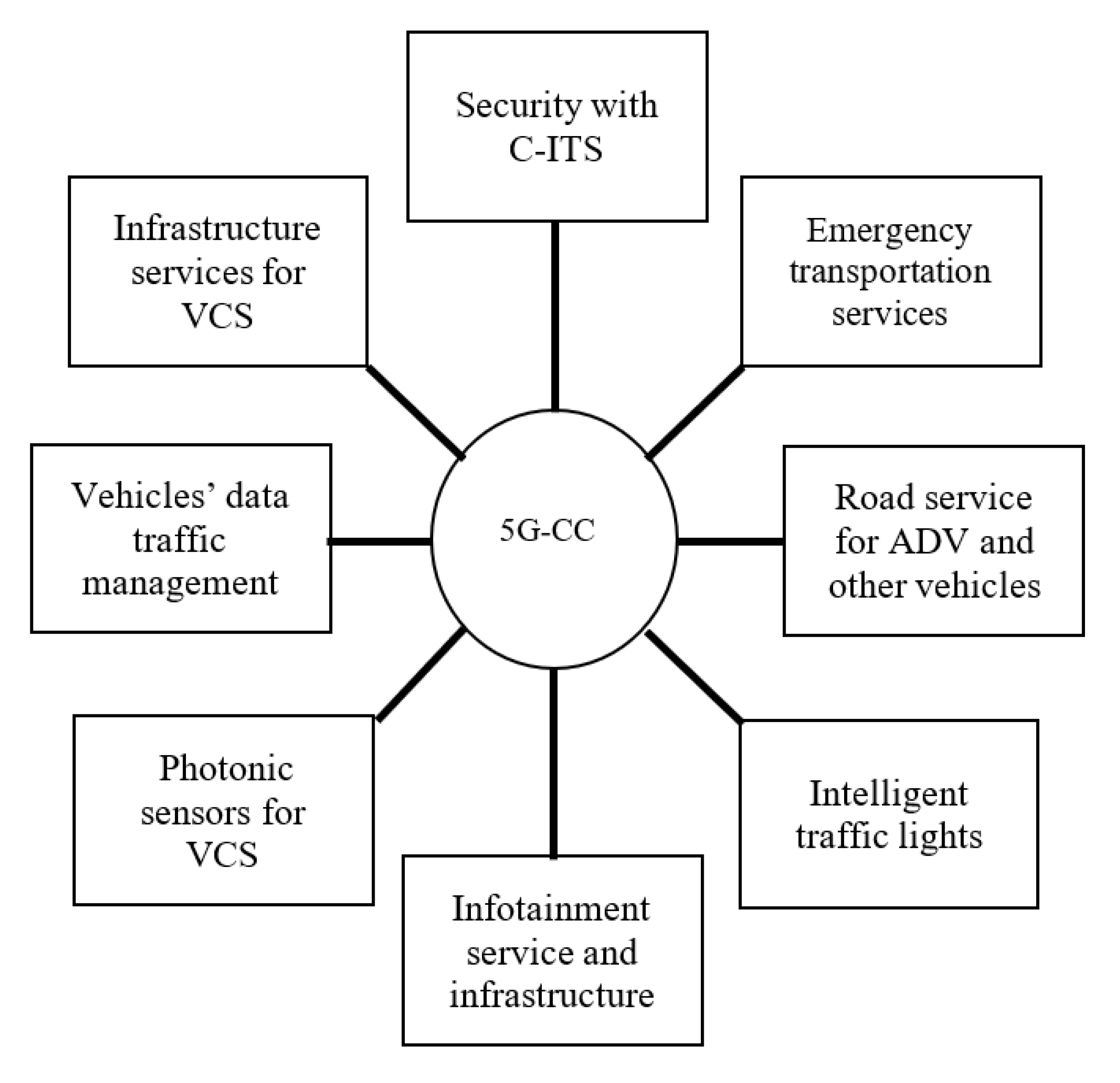
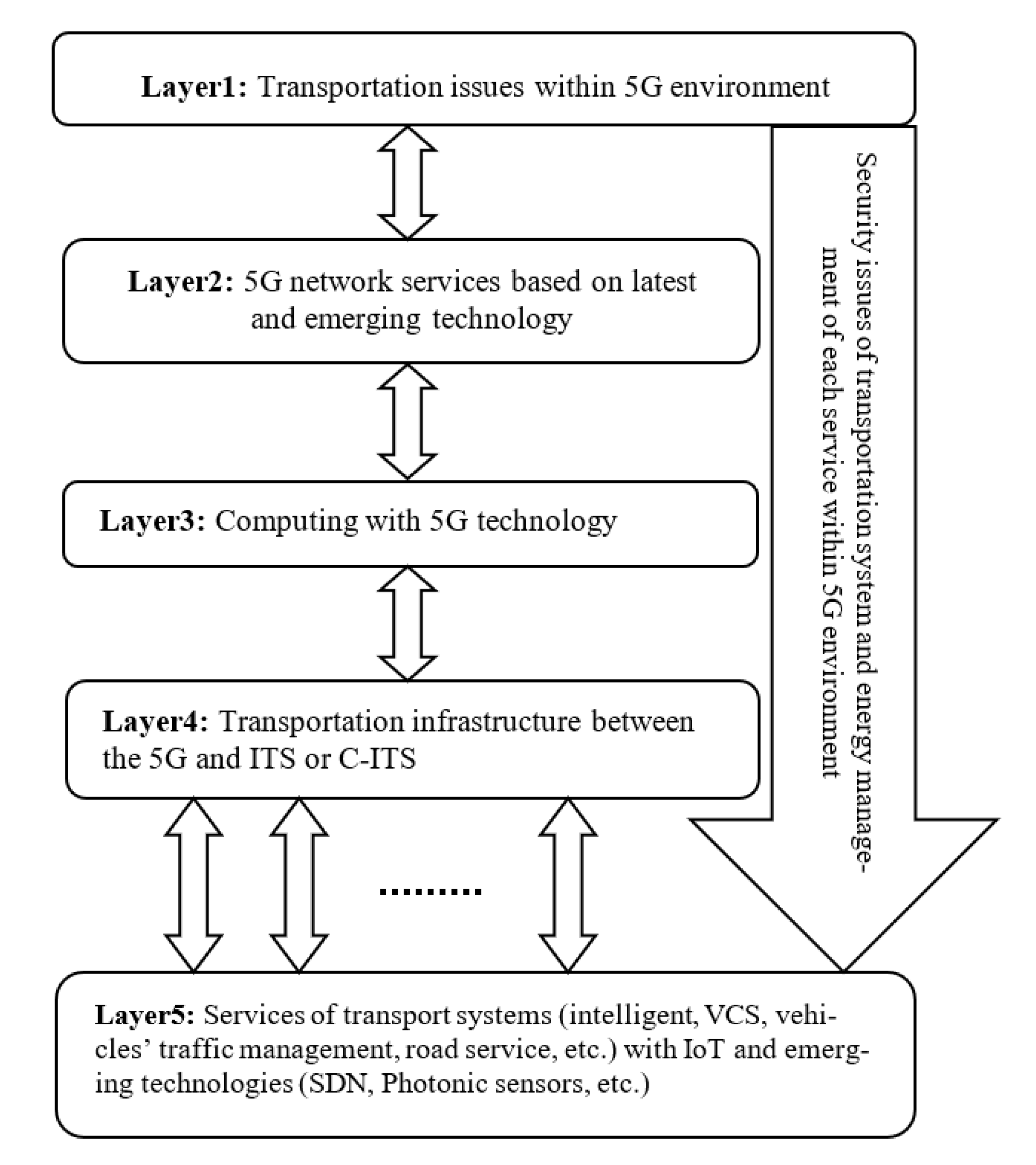
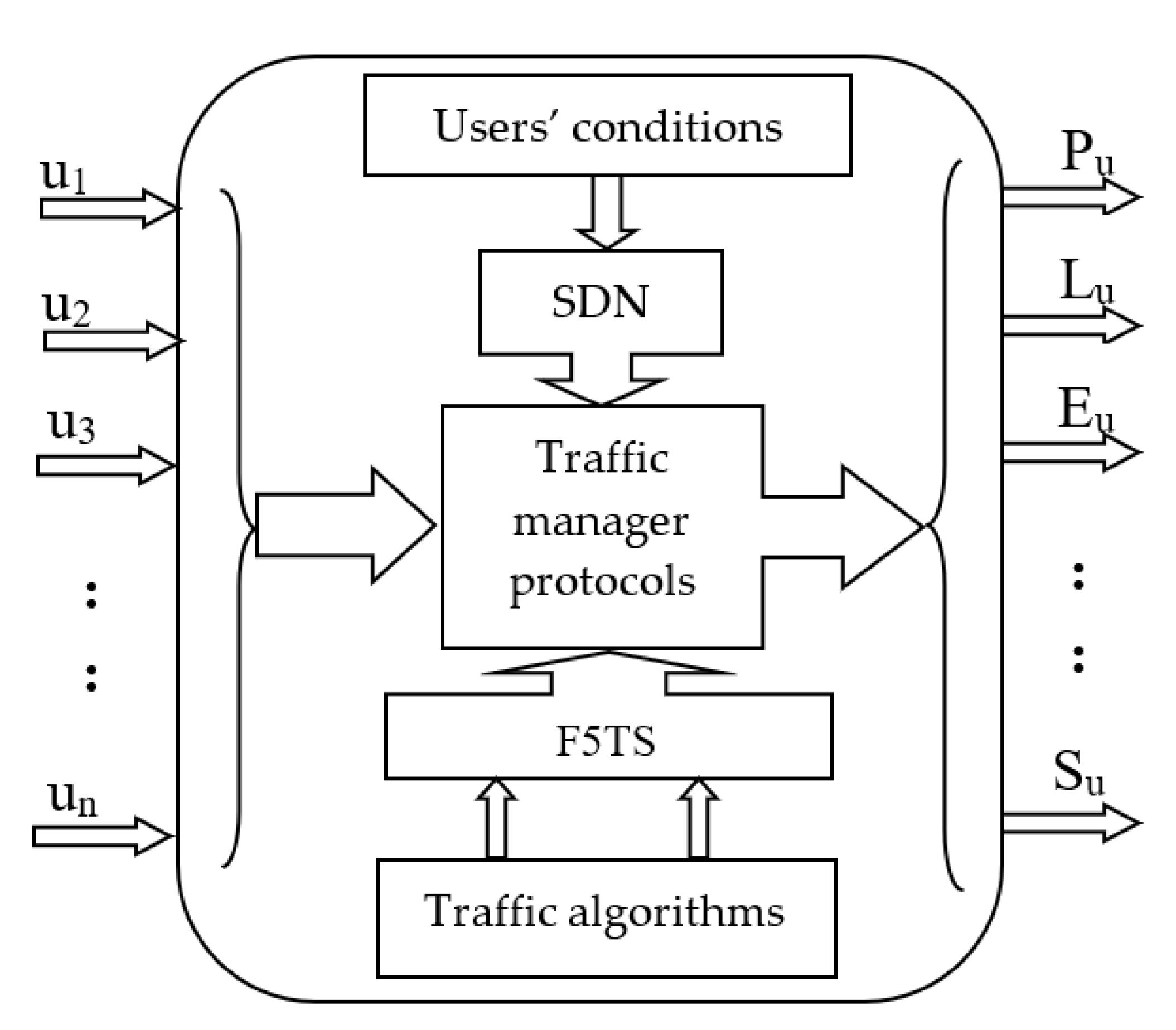

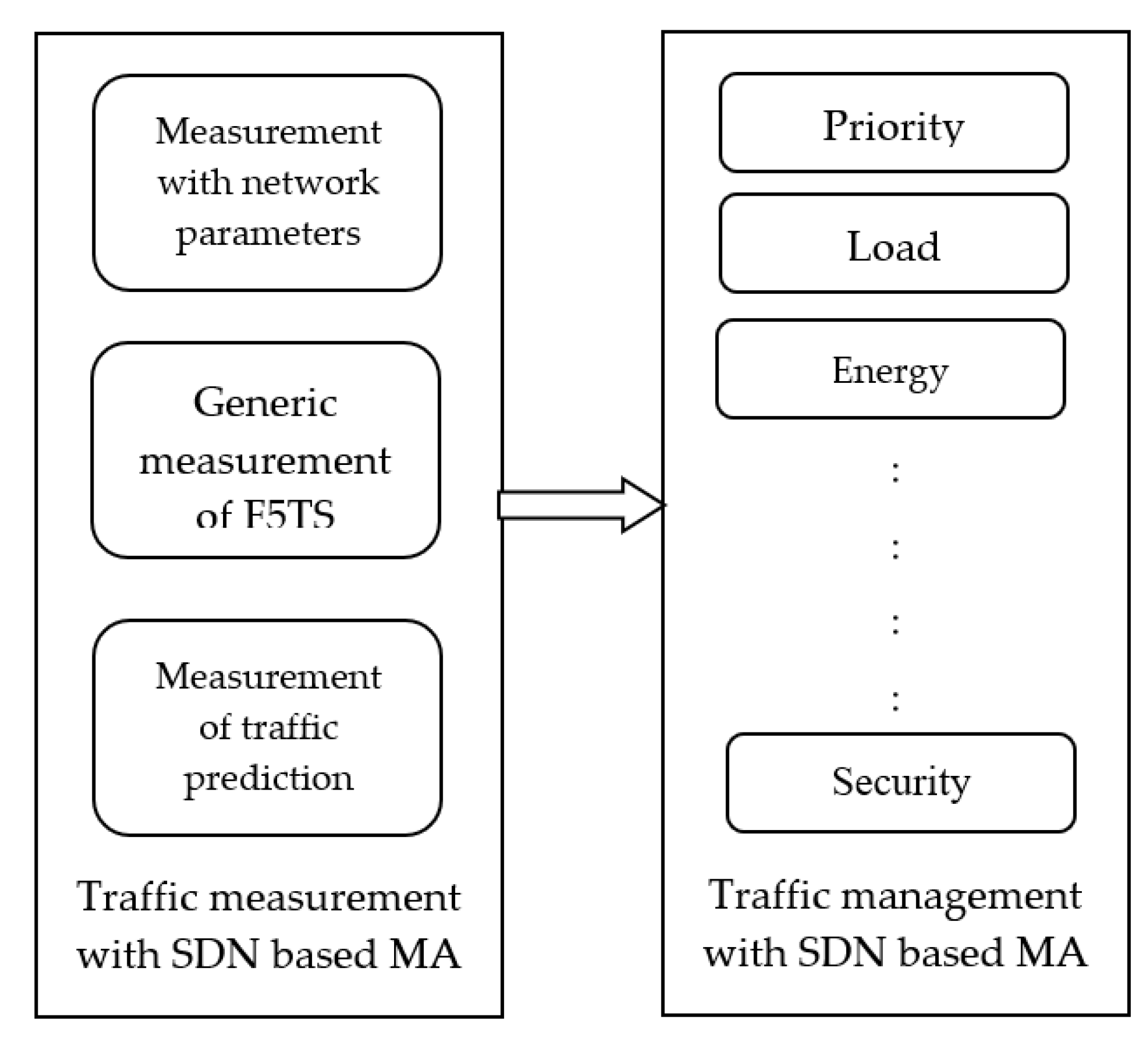
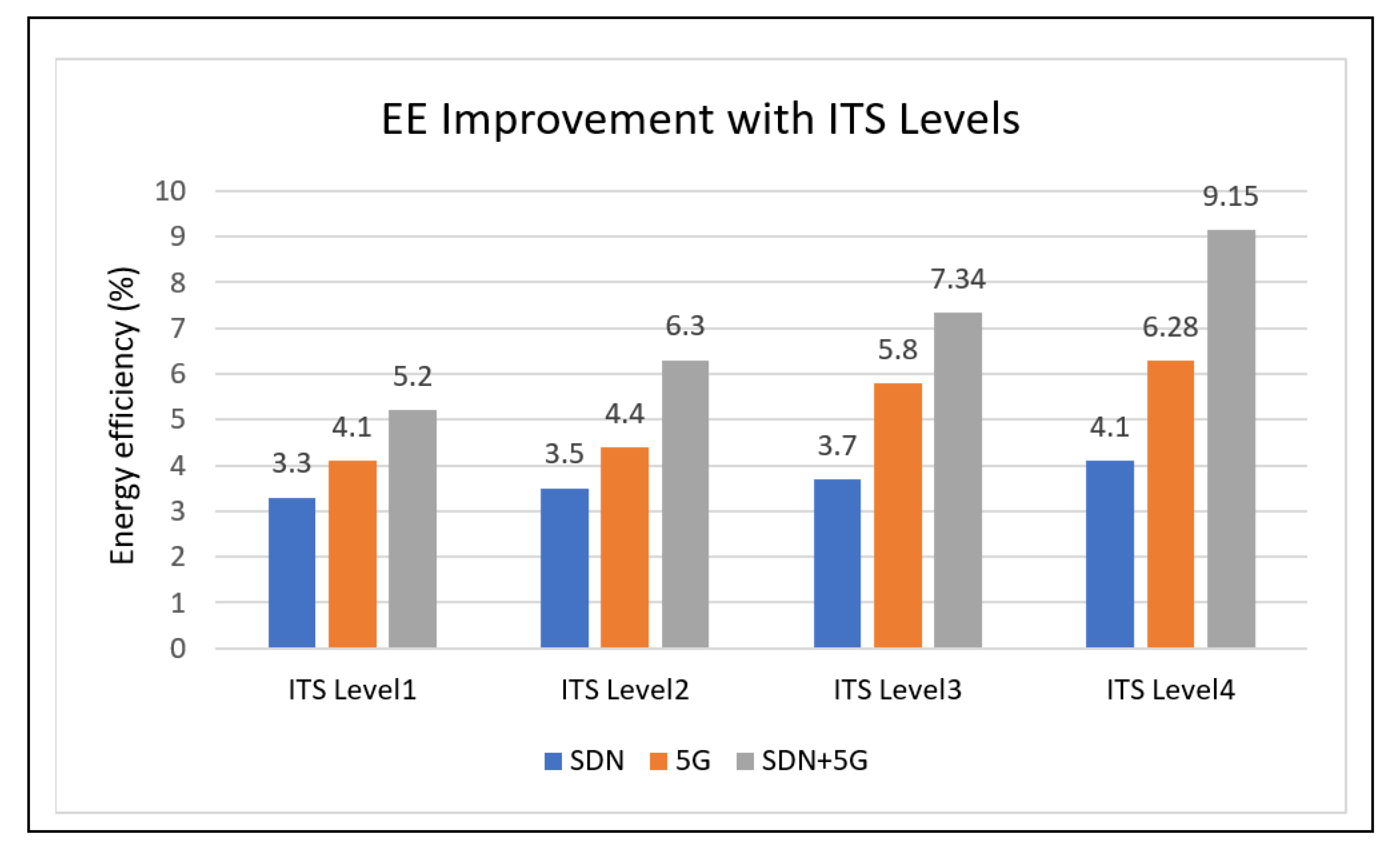

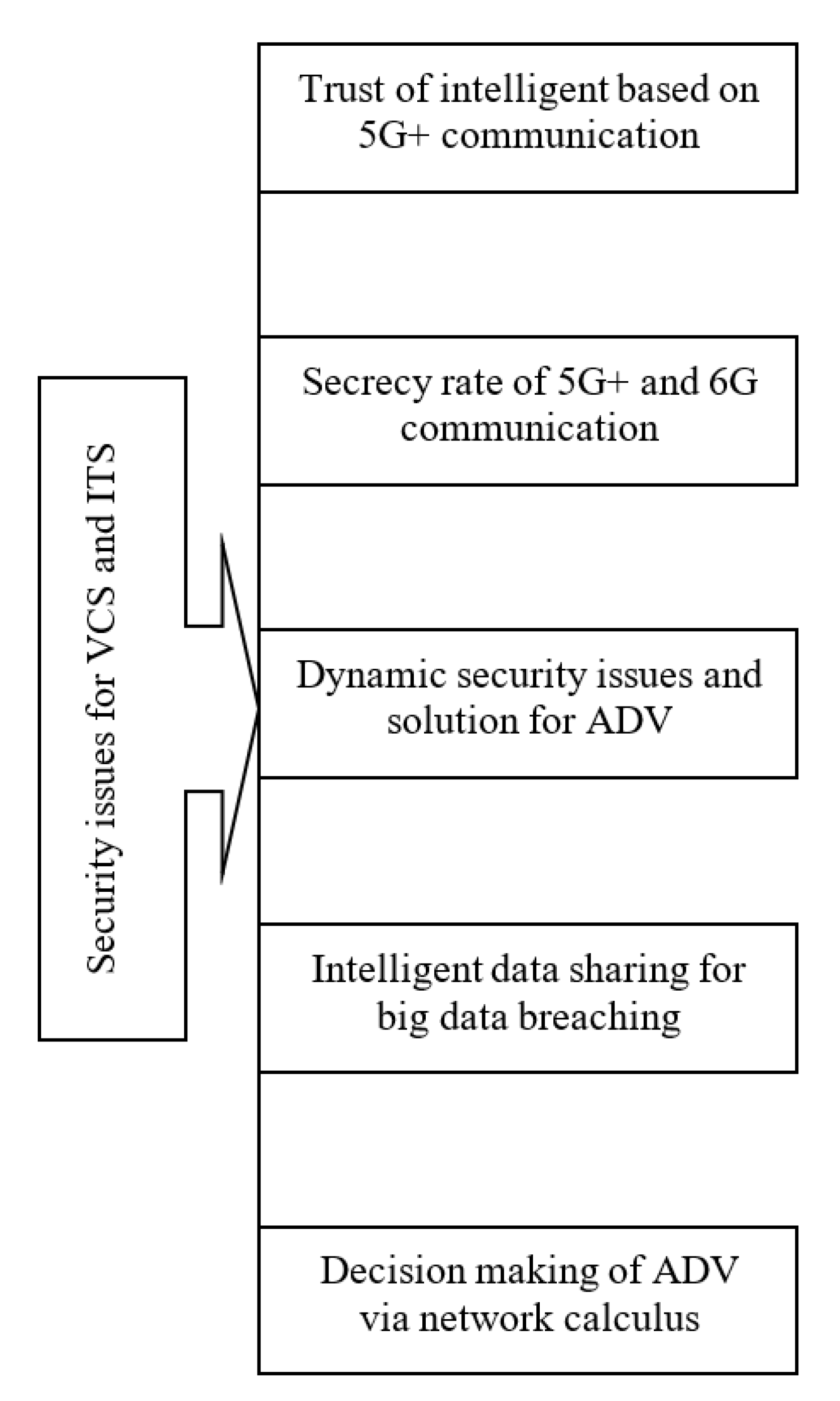
| Schemes | Requirements for Analyzing Data Traffic of the Transportation System | Overall Benefits for Improving Data Traffic |
|---|---|---|
| NOMA | Power allocations | High spectral efficiency |
| SCMA | Sparse coding schemes with non-orthogonal codes | More diversity |
| PDMA | Specific pattern division schemes with non-orthogonal codes | Efficient receiver with low complexity |
| MUMA | Legacy coding schemes with non-orthogonal codes | Better EE |
| BOMA | Building block sparse constellation | Simple and low complex receiver |
| LPMA | Multilevel lattice code | Power and code domain |
| Selected Scenarios | Expected Functionalities of 5G MA | Measurement Details of Services Used for Managing the Traffic of Transportation |
|---|---|---|
| eMBB | Large network capacity High user density Uniform user experience Easy multi-user multi-inputs multi outputs (MU-MIMO) Mixed traffic types of transmission Highly efficient small packets transmission | Power Bandwidth, spectrum Uptime, availability EE, spectral efficiency, etc. Rates, packet details, etc. Packet size and rate details |
| mmWave | Degree of multi-connectivity | End-to-end round-trip latency, inter-site distance |
| mMTC | Massive connectivity Highly efficient small packets transmission | Complexity, scalability Packet size and rate details |
| URLLC | Ultra-low latency transmission Ultra-high reliability transmission Highly efficient small packets transmission | Accuracy of latency Lifetime, EE Packet size and rate details |
| IoT | Massive connectivity | Complexity, scalability |
| Relay | Higher fidelity by jointly processing Extended coverage | Signal to noise ratio Power and some users |
| LTE | Connectivity | Adequate power control |
| WiFi | Connectivity | Fixed-power transmissions |
| V2V | Lower collision probability Higher resource utilization | Power and secrecy Complexity, EE, etc. |
| ITS Levels | Traditional e > 0.05 | SDN E = 0.05 | SDN e = 0.005 | SDN e = 0.001 |
|---|---|---|---|---|
| Driver-assisted ADVs | 20% | 35% | 40% | 50% |
| Partial ADVs | 30% | 40% | 45% | 55% |
| Limited condition ADVs | 35% | 45% | 50% | 60% |
| Full ADVs | 25% | 40% | 55% | 70% |
Publisher’s Note: MDPI stays neutral with regard to jurisdictional claims in published maps and institutional affiliations. |
© 2021 by the authors. Licensee MDPI, Basel, Switzerland. This article is an open access article distributed under the terms and conditions of the Creative Commons Attribution (CC BY) license (https://creativecommons.org/licenses/by/4.0/).
Share and Cite
Algarni, A.; Thayananthan, V. Improvement of 5G Transportation Services with SDN-Based Security Solutions and beyond 5G. Electronics 2021, 10, 2490. https://doi.org/10.3390/electronics10202490
Algarni A, Thayananthan V. Improvement of 5G Transportation Services with SDN-Based Security Solutions and beyond 5G. Electronics. 2021; 10(20):2490. https://doi.org/10.3390/electronics10202490
Chicago/Turabian StyleAlgarni, Abdullah, and Vijey Thayananthan. 2021. "Improvement of 5G Transportation Services with SDN-Based Security Solutions and beyond 5G" Electronics 10, no. 20: 2490. https://doi.org/10.3390/electronics10202490
APA StyleAlgarni, A., & Thayananthan, V. (2021). Improvement of 5G Transportation Services with SDN-Based Security Solutions and beyond 5G. Electronics, 10(20), 2490. https://doi.org/10.3390/electronics10202490






